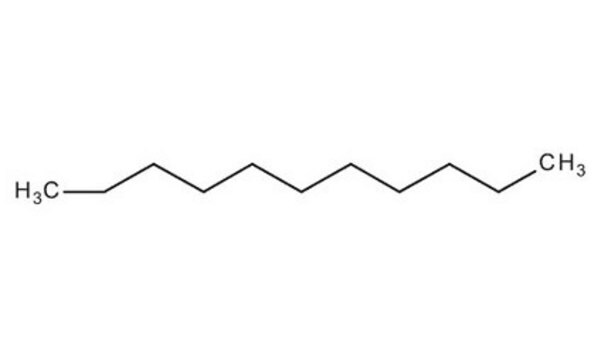W510505
Undecane
≥99%
Synonym(s):
n-Undecane, Hendecane
About This Item
Recommended Products
biological source
synthetic
Quality Level
grade
Fragrance grade
Agency
follows IFRA guidelines
reg. compliance
EU Regulation 1223/2009
FDA 21 CFR 117
vapor density
5.4 (vs air)
vapor pressure
<0.4 mmHg ( 20 °C)
Assay
≥99%
refractive index
n20/D 1.417 (lit.)
bp
196 °C (lit.)
mp
−26 °C (lit.)
density
0.74 g/mL at 25 °C (lit.)
application(s)
flavors and fragrances
Documentation
see Safety & Documentation for available documents
food allergen
no known allergens
fragrance allergen
no known allergens
Organoleptic
faint
SMILES string
CCCCCCCCCCC
InChI
1S/C11H24/c1-3-5-7-9-11-10-8-6-4-2/h3-11H2,1-2H3
InChI key
RSJKGSCJYJTIGS-UHFFFAOYSA-N
Looking for similar products? Visit Product Comparison Guide
Related Categories
General description
Application
- Preparation and Performance Study of n-Undecane Phase Change Cold Storage Material.: This study focuses on the preparation and performance of n-undecane as a phase change material for cold storage applications. The research highlights its thermal properties and potential use in energy storage systems, offering advancements in material science and energy efficiency (Yan et al., 2024).
Disclaimer
Signal Word
Danger
Hazard Statements
Precautionary Statements
Hazard Classifications
Asp. Tox. 1 - Flam. Liq. 3
Supplementary Hazards
Storage Class Code
3 - Flammable liquids
WGK
WGK 3
Flash Point(F)
140.0 °F - closed cup
Flash Point(C)
60 °C - closed cup
Personal Protective Equipment
Choose from one of the most recent versions:
Already Own This Product?
Find documentation for the products that you have recently purchased in the Document Library.
Customers Also Viewed
Global Trade Item Number
| SKU | GTIN |
|---|---|
| W510505-1KG | 4061838258274 |
| W510505-SAMPLE | 4061837542244 |
| W510505-4KG | 4061838258281 |
| W510505-8KG |
Our team of scientists has experience in all areas of research including Life Science, Material Science, Chemical Synthesis, Chromatography, Analytical and many others.
Contact Technical Service









